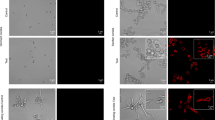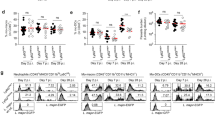Abstract
Pentraxins are a superfamily of conserved proteins involved in the acute-phase response and innate immunity. Pentraxin 3 (PTX3), a prototypical member of the long pentraxin subfamily, is a key component of the humoral arm of innate immunity that is essential for resistance to certain pathogens. A regulatory role for pentraxins in inflammation has long been recognized, but the underlying mechanisms remain unclear. Here we report that PTX3 bound P-selectin and attenuated neutrophil recruitment at sites of inflammation. PTX3 released from activated leukocytes functioned locally to dampen neutrophil recruitment and regulate inflammation. Antibodies have glycosylation-dependent regulatory effect on inflammation. Therefore, PTX3, which is an essential component of humoral innate immunity, and immunoglobulins share functional outputs, including complement activation, opsonization and, as shown here, glycosylation-dependent regulation of inflammation.
This is a preview of subscription content, access via your institution
Access options
Subscribe to this journal
Receive 12 print issues and online access
$259.00 per year
only $21.58 per issue
Buy this article
- Purchase on SpringerLink
- Instant access to full article PDF
Prices may be subject to local taxes which are calculated during checkout








Similar content being viewed by others
References
Garlanda, C., Bottazzi, B., Bastone, A. & Mantovani, A. Pentraxins at the crossroads between innate immunity, inflammation, matrix deposition, and female fertility. Annu. Rev. Immunol. 23, 337–366 (2005).
Pepys, M.B. & Hirschfield, G.M. C-reactive protein: a critical update. J. Clin. Invest. 111, 1805–1812 (2003).
Bottazzi, B. et al. The long pentraxin PTX3 as a prototypic humoral pattern recognition receptor: interplay with cellular innate immunity. Immunol. Rev. 227, 9–18 (2009).
Jeannin, P. et al. Complexity and complementarity of outer membrane protein A recognition by cellular and humoral innate immunity receptors. Immunity 22, 551–560 (2005).
Doni, A. et al. Regulation of PTX3, a key component of humoral innate immunity in human dendritic cells: stimulation by IL-10 and inhibition by IFN-γ. J. Leukoc. Biol. 79, 797–802 (2006).
Jaillon, S. et al. The humoral pattern recognition receptor PTX3 is stored in neutrophil granules and localizes in extracellular traps. J. Exp. Med. 204, 793–804 (2007).
Cotena, A. et al. Complement dependent amplification of the innate response to a cognate microbial ligand by the long pentraxin PTX3. J. Immunol. 179, 6311–6317 (2007).
Nauta, A.J. et al. Biochemical and functional characterization of the interaction between pentraxin 3 and C1q. Eur. J. Immunol. 33, 465–473 (2003).
Deban, L. et al. Binding of the long pentraxin PTX3 to factor H: interacting domains and function in the regulation of complement activation. J. Immunol. 181, 8433–8440 (2008).
Diniz, S.N. et al. PTX3 function as an opsonin for the dectin-1-dependent internalization of zymosan by macrophages. J. Leukoc. Biol. 75, 649–656 (2004).
Garlanda, C. et al. Non-redundant role of the long pentraxin PTX3 in anti-fungal innate immune response. Nature 420, 182–186 (2002).
Soares, A.C. et al. Dual function of the long pentraxin PTX3 in resistance against pulmonary infection with Klebsiella pneumoniae in transgenic mice. Microbes Infect. 8, 1321–1329 (2006).
Dias, A.A. et al. TSG-14 transgenic mice have improved survival to endotoxemia and to CLP-induced sepsis. J. Leukoc. Biol. 69, 928–936 (2001).
Ravizza, T. et al. Dynamic induction of the long pentraxin PTX3 in the CNS after limbic seizures: evidence for a protective role in seizure-induced neurodegeneration. Neuroscience 105, 43–53 (2001).
Salio, M. et al. Cardioprotective function of the long pentraxin PTX3 in acute myocardial infarction. Circulation 117, 1055–1064 (2008).
Mold, C., Rodriguez, W., Rodic-Polic, B. & Du Clos, T.W. C-reactive protein mediates protection from lipopolysaccharide through interactions with FcγR. J. Immunol. 169, 7019–7025 (2002).
Rodriguez, W. et al. C-reactive protein-mediated suppression of nephrotoxic nephritis: role of macrophages, complement, and Fcγ receptors. J. Immunol. 178, 530–538 (2007).
Tennent, G.A. et al. Transgenic human CRP is not pro-atherogenic, pro-atherothrombotic or pro-inflammatory in apoE−/− mice. Atherosclerosis 196, 248–255 (2008).
Noursadeghi, M. et al. Role of serum amyloid P component in bacterial infection: protection of the host or protection of the pathogen. Proc. Natl. Acad. Sci. USA 97, 14584–14589 (2000).
Vestweber, D. & Blanks, J.E. Mechanisms that regulate the function of the selectins and their ligands. Physiol. Rev. 79, 181–213 (1999).
Springer, T.A. Traffic signals for lymphocyte recirculation and leukocyte emigration: the multistep paradigm. Cell 76, 301–314 (1994).
McEver, R.P. Selectins: lectins that initiate cell adhesion under flow. Curr. Opin. Cell Biol. 14, 581–586 (2002).
Lowe, J.B. Glycan-dependent leukocyte adhesion and recruitment in inflammation. Curr. Opin. Cell Biol. 15, 531–538 (2003).
Kansas, G.S. Selectins and their ligands: current concepts and controversies. Blood 88, 3259–3287 (1996).
Ley, K. & Reutershan, J. Leucocyte-endothelial interactions in health and disease. Handb. Exp. Pharmacol. 176, 97–133 (2006).
Hartwell, D.W. & Wagner, D.D. New discoveries with mice mutant in endothelial and platelet selectins. Thromb. Haemost. 82, 850–857 (1999).
Mayadas, T.N., Johnson, R.C., Rayburn, H., Hynes, R.O. & Wagner, D.D. Leukocyte rolling and extravasation are severely compromised in P selectin-deficient mice. Cell 74, 541–554 (1993).
Yang, J. et al. Targeted gene disruption demonstrates that P-selectin glycoprotein ligand 1 (PSGL-1) is required for P-selectin-mediated but not E-selectin-mediated neutrophil rolling and migration. J. Exp. Med. 190, 1769–1782 (1999).
Sprong, T. et al. Pentraxin 3 and C-reactive protein in severe meningococcal disease. Shock 31, 28–32 (2009).
Stibenz, D. et al. Binding of human serum amyloid P component to L-selectin. Eur. J. Immunol. 36, 446–456 (2006).
Mehta, P., Cummings, R.D. & McEver, R.P. Affinity and kinetic analysis of P-selectin binding to P-selectin glycoprotein ligand-1. J. Biol. Chem. 273, 32506–32513 (1998).
Yang, J., Furie, B.C. & Furie, B. The biology of P-selectin glycoprotein ligand-1: its role as a selectin counterreceptor in leukocyte-endothelial and leukocyte-platelet interaction. Thromb. Haemost. 81, 1–7 (1999).
Inforzato, A. et al. Structure and function of the long pentraxin PTX3 glycosidic moiety: fine-tuning of the interaction with C1q and complement activation. Biochemistry 45, 11540–11551 (2006).
Mauri, T. et al. Persisting high levels of plasma pentraxin 3 (PTX3) over the first days from severe sepsis and septic shock onset are associated with mortality. Intensive Care Med. (published online, doi:10.1007/s00134-010-1752-5 (30 January 2010)).
Muller, B. et al. Circulating levels of the long pentraxin PTX3 correlate with severity of infection in critically ill patients. Crit. Care Med. 29, 1404–1407 (2001).
Inforzato, A. et al. Structural characterization of PTX3 disulfide bond network and its multimeric status in cumulus matrix organization. J. Biol. Chem. 283, 10147–10161 (2008).
Vestweber, D. The selectins and their ligands. Curr. Top. Microbiol. Immunol. 184, 65–75 (1993).
Dole, V.S., Bergmeier, W., Mitchell, H.A., Eichenberger, S.C. & Wagner, D.D. Activated platelets induce Weibel-Palade-body secretion and leukocyte rolling in vivo: role of P-selectin. Blood 106, 2334–2339 (2005).
Miotla, J.M., Ridger, V.C. & Hellewell, P.G. Dominant role of L- and P-selectin in mediating CXC chemokine-induced neutrophil migration in vivo. Br. J. Pharmacol. 133, 550–556 (2001).
Pinho, V. et al. Tissue- and stimulus-dependent role of phosphatidylinositol 3-kinase isoforms for neutrophil recruitment induced by chemoattractants in vivo. J. Immunol. 179, 7891–7898 (2007).
Breviario, F. et al. Interleukin-1-inducible genes in endothelial cells. Cloning of a new gene related to C-reactive protein and serum amyloid P component. J. Biol. Chem. 267, 22190–22197 (1992).
Lee, G.W., Lee, T.H. & Vilcek, J. TSG-14, a tumor necrosis factor- and IL-1-inducible protein, is a novel member of the pentaxin family of acute phase proteins. J. Immunol. 150, 1804–1812 (1993).
Mulligan, M.S. et al. Protective effects of oligosaccharides in P-selectin-dependent lung injury. Nature 364, 149–151 (1993).
Rubenfeld, G.D. et al. Incidence and outcomes of acute lung injury. N. Engl. J. Med. 353, 1685–1693 (2005).
Ware, L.B. & Matthay, M.A. The acute respiratory distress syndrome. N. Engl. J. Med. 342, 1334–1349 (2000).
Zarbock, A., Singbartl, K. & Ley, K. Complete reversal of acid-induced acute lung injury by blocking of platelet-neutrophil aggregation. J. Clin. Invest. 116, 3211–3219 (2006).
Reading, P.C. et al. Antiviral activity of the long chain pentraxin PTX3 against influenza viruses. J. Immunol. 180, 3391–3398 (2008).
Kaneko, Y., Nimmerjahn, F. & Ravetch, J.V. Anti-inflammatory activity of immunoglobulin G resulting from Fc sialylation. Science 313, 670–673 (2006).
Kunkel, E.J. et al. Absence of trauma-induced leukocyte rolling in mice deficient in both P-selectin and intercellular adhesion molecule 1. J. Exp. Med. 183, 57–65 (1996).
Bolomini-Vittori, M. et al. Regulation of conformer-specific activation of the integrin LFA-1 by a chemokine-triggered Rho signaling module. Nat. Immunol. 10, 185–194 (2009).
Piccio, L. et al. Molecular mechanisms involved in lymphocyte recruitment in inflamed brain microvessels: critical roles for P-selectin glycoprotein ligand-1 and heterotrimeric Gi-linked receptors. J. Immunol. 168, 1940–1949 (2002).
Ley, K. & Gaehtgens, P. Endothelial, not hemodynamic, differences are responsible for preferential leukocyte rolling in rat mesenteric venules. Circ. Res. 69, 1034–1041 (1991).
Fabene, P.F. et al. A role for leukocyte-endothelial adhesion mechanisms in epilepsy. Nat. Med. 14, 1377–1383 (2008).
Acknowledgements
We thank D. Vestweber (Max Planck Institute for Molecular Biomedicine) for blocking monoclonal antibody to mouse P-selectin (Rb40.34); M. Locati (Istituto Clinico Humanitas, Rozzano, and University of Milan) for CHO cells transfected with the chemokine decoy receptor D6; G. Kansas (Northwestern University) for P-selectin-transfected CHO cells. F. Fumagalli (Istituto di Ricerche Farmacologiche Mario Negri) and M. Amigoni (University of Milano-Bicocca) for support in acute lung injury experiments; M. Stravalaci for assistance; and members of the Laboratory for Immunology and Inflammation for advice and discussions. Supported by the European Commission (HEALTH-F4-2008-202156 TOLERAGE), the European Research Council (project HIIS), Telethon (GGP05095), the Cassa di Risparmio delle Provincie Lombarde Foundation (NOBEL project), Ministero Università e Ricerca (MIUR–FIRBRBLA039LSF), the University of Milan (FIRST project), the Fondazione Humanitas per la Ricerca and Italian Association for Cancer Research, the International Graduate School in Molecular Medicine (Vita-Salute San Raffaele University, Italy; L.D.), the European Molecular Biology Organization (ASTF 293-2008 to L.D.), the National Institutes of Health (HL080166 to V.E.), the Fondazione Cariverona, Italian Ministry of Education and Research (G.C.), Fondazione Italiana Sclerosi Multipla, Genova, Italy (G.C.) and the National Multiple Sclerosis Society (G.C.).
Author information
Authors and Affiliations
Contributions
L.D., B.B. and A.M. planned the research, analyzed and interpreted data and wrote the manuscript; L.D., R.C.R., M.Sironi., F.M., M.Scanziani and V.Z. did the animal experiments; A.B. and M.G. did the SPR experiments; C.L. did and analyzed leukocyte rolling experiments; S.V. and I.C. participated in purification of recombinant proteins and helped with mouse breeding and genotyping; L.D. and A.D. did and analyzed flow cytometry and microtiter plate binding assays; G.S. generated deglycosylated PTX3 by enzymatic digestion; M.Sassano. generated deglycosylated PTX3 by site-directed mutagenesis; G.C., B.R. and E.Z. did and analyzed the intravital microscopy experiments; and C.G., V.E. and S.D. contributed to data analysis and interpretation.
Corresponding author
Ethics declarations
Competing interests
The authors declare no competing financial interests.
Supplementary information
Supplementary Text and Figures
Supplementary Figures 1–10, Tables 1–2 and Supplementary Methods (PDF 612 kb)
Rights and permissions
About this article
Cite this article
Deban, L., Russo, R., Sironi, M. et al. Regulation of leukocyte recruitment by the long pentraxin PTX3. Nat Immunol 11, 328–334 (2010). https://doi.org/10.1038/ni.1854
Received:
Accepted:
Published:
Issue date:
DOI: https://doi.org/10.1038/ni.1854
This article is cited by
-
Role of long pentraxin PTX3 in cancer
Clinical and Experimental Medicine (2023)
-
Clinical Utility of Circulating Pentraxin 3 as a Prognostic Biomarker in Coronavirus Disease 2019: A Systematic Review and Meta-analysis
Infectious Diseases and Therapy (2023)
-
Negative Regulators of Inflammation Response to the Dynamic Expression of Cytokines in DF-1 and MDCK Cells Infected by Avian Influenza Viruses
Inflammation (2022)
-
Pentraxin 3 in Circulating Microvesicles: a Potential Biomarker for Acute Heart Failure After Cardiac Surgery with Cardiopulmonary Bypass
Journal of Cardiovascular Translational Research (2022)
-
Long pentraxin PTX3 is upregulated systemically and centrally after experimental neurotrauma, but its depletion leaves unaltered sensorimotor deficits or histopathology
Scientific Reports (2021)



